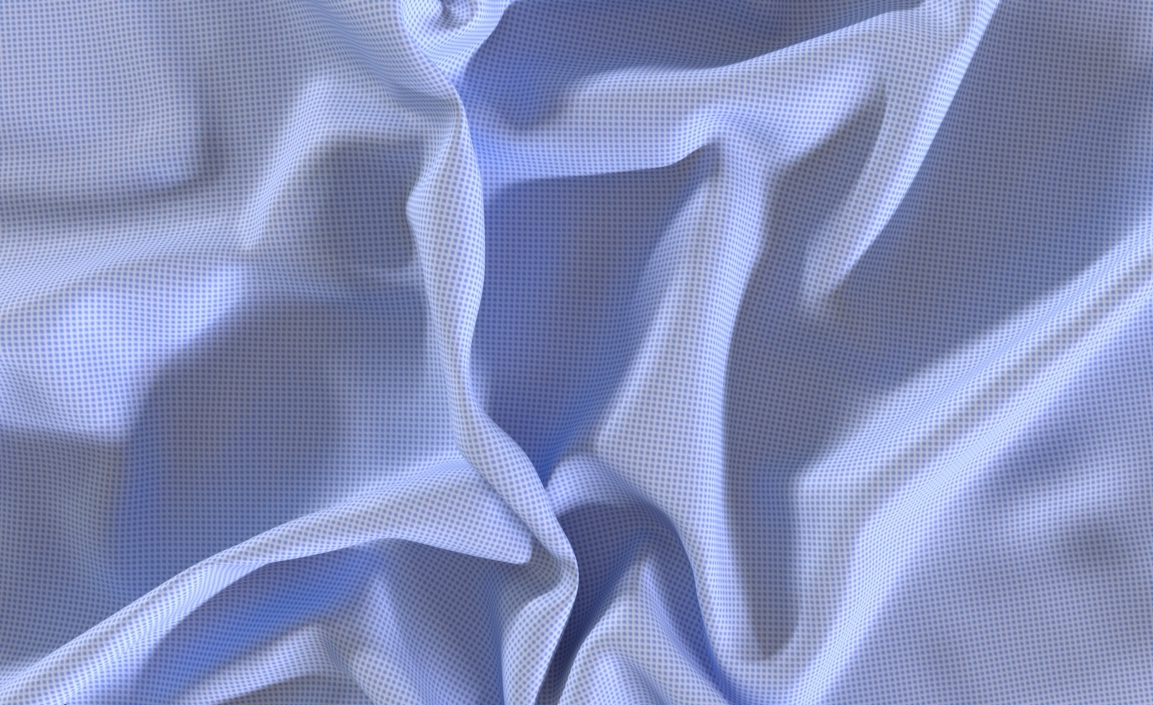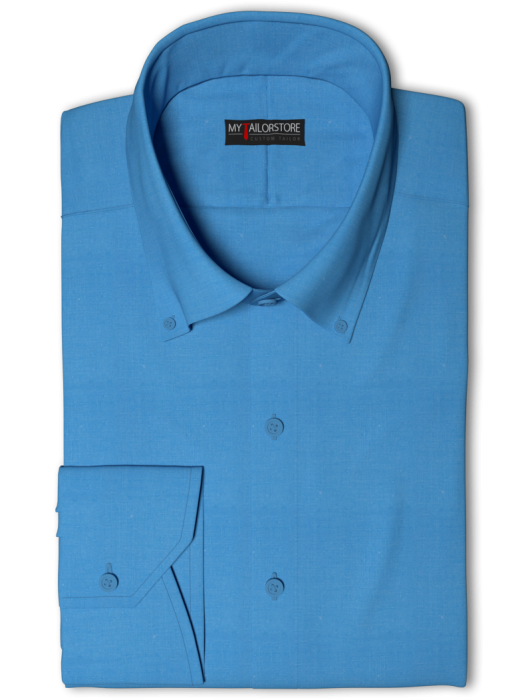-
Your shopping cart is empty!
Button Down Casual Shirt-Limerick, linen Cyan Blue
SHIRT COLLAR
A "collar" is an essential component of a shirt, blouse, or garment worn around the neck. It serves both practical and aesthetic purposes. Collars come in various styles, each with distinct characteristics, and they have evolved over time to accommodate different fashion trends and functional needs.
From a functional perspective, collars provide structural support to the garment's neckline. They help maintain the shirt's shape and keep it in place on the wearer's shoulders. Depending on the design and style, collars can offer varying degrees of rigidity and comfort. Some collars, like the button-down and hidden button-down collars, feature small buttons or hidden fasteners that secure the points to the shirt, ensuring they remain in place during wear.
Beyond their functional role, collars have a significant impact on the overall appearance and formality of a garment. Different collar styles can transform the look and convey specific messages. For example, the wing collar is a traditional choice for tuxedos and black-tie events, denoting a high level of formality. In contrast, the club collar, with its rounded points, adds a touch of vintage flair and casual sophistication.
Collars also play a crucial role in coordinating with neckwear, such as ties, bow ties, or scarves. Collar styles influence the choice of neckwear and how it is knotted or fastened. The spread and width of the collar determine the space available for various tie knots, allowing for customization of the wearer's appearance.
In recent years, collar fashion has seen the resurgence of traditional and retro styles, reflecting a blend of classic and contemporary sensibilities. Collars like the Mandarin (or Chinese) collar have become popular for their minimalistic and modern appeal, while the clerical collar maintains its historical significance in religious contexts.
In summary, a collar serves as a crucial element in clothing design, balancing functionality and style. It defines the neckline, influences the formality of the attire, and complements neckwear choices, making it a versatile and integral aspect of modern fashion.
SHIRT SLEEVES
SHORT SLEEVESStandard Short sleeves. Following cuffs style can be selected with this option
|
LONG SLEEVESStandard Long sleeves attached with a cuff. Following cuffs style can be selected with this option
|
LONG SLEEVES WITH TABStandard Long sleeves additional there will a small tab stitched inside of the sleeve which will hold the shirt cuff with the help of a button. This option is mainly for a casual shirt style. Sleeves are going to be slightly wider as you can only use the tab if you are rolling up the sleeves. Following cuffs style can be selected with this option
|
SHORT SLEEVES WITH TABStandard short sleeves additional there will a small tab stitched inside of the sleeve and will always be seen outside of the sleeves . This option is mainly for a casual shirt style. Following cuffs style can be selected with this option
|
SHIRT CUFF
A Cuff is a layer of texture at the lower edge of the sleeve of an article of clothing mainly shirt and pants
 BARREL 1 BUTTONClassic cuff for all occasions and customer favourites. Length of 2 ½", button on both sides so that tightness will be adjustable as per watch. |
 BARREL 2 BUTTONSBarrel cuff with 2 buttons. Length 3" higher than the standard cuff. |
 BARREL 3 BUTTONSBarrel cuff with 3 buttons. Length of 3 ¼" with 3 buttons for those who want something different. |
 FRENCH CUFFS or DOUBLE CUFFSFormal cuffs with Length of 5" folded into half creating 2 layers. Both sides buttonhole to use with cufflinks or Knots. |
 CASINO CUFFSAlso, a type of formal cuff to use with buttons instead of cufflinks. |
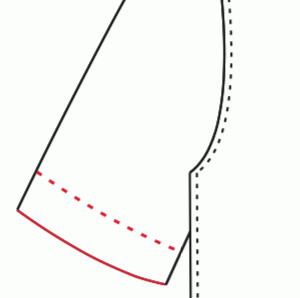 SHORT WITH SEAMStandard seam for short sleeves shirt. |
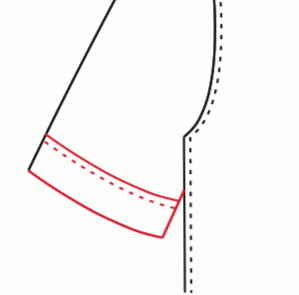 SHORT WITH CUFFShorts sleeves shirt with a cuff |
 SHORT WITH SPLITFor short sleeves shirt with cuffs and split on sides |
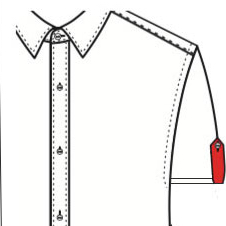 SHORT WITH TABFor short sleeve shirt with the tab for a more casual look or to roll up the shirt sleeves |
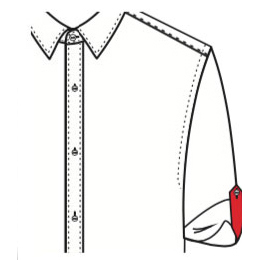 LONG WITH TABTab to roll up the sleeves. Sleeves are going to be slightly wider so that you can rollup easily. Cuff will be soft with only one layer of interlining. |
SHIRT BACK
A yoke is a shaped pattern piece which forms part of a garment, usually fitting around the neck and shoulders, or around the hips to provide support for looser parts of the garment, such as a gathered skirt or the body of a shirt.
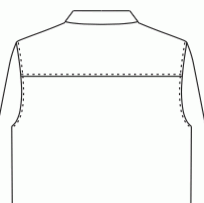 Plain BackOne-piece yoke for those who like slim fit |
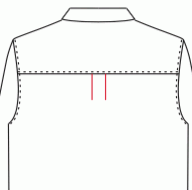 Boxed Center PleatOne Piece yoke with pleat in the middle. Recommended for those who like little extra room at the back. |
 Side pleatOne Piece yoke with pleats on both sides for extra room. Not recommended for sloping shoulders. |
 Plain back with dartsFor all Body form, slim-fit and more tapered at the waist. |
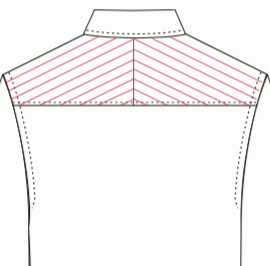 Split Yoke without dartsFor all Body forms, slim-fit but with extra comfort as split yoke helps to stretch the fabric. |
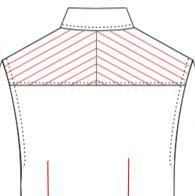 Split Yoke with dartsFor all Body forms, slim-fit but with extra comfort as split yoke helps to stretch the fabric and with extra tapered look at waist. |
SHIRT PLACKET
A placket (also spelled placquet) is an opening in the upper part of trousers or skirts, or at the neck or sleeve of a garment.[1] Plackets are almost always used to allow clothing to be put on or removed easily but are sometimes used purely as a design element. Modern plackets often contain fabric facings or attached bands to surround and reinforce fasteners such as buttons, snaps, or zippers.
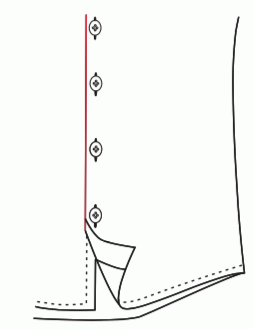 PLAIN FRONT W/O SEAMPlain front without seam with a more smooth and cleaner look |
 PLAIN FRONT WITH SEAMPlain front with a seam following next to the buttons. |
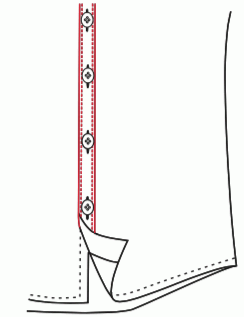 PLACKET FRONTA soft fused placket mainly for a casual and relaxed look. |
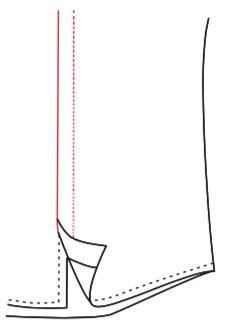 HID BUTTON SEAMHidden button with seam. Buttons are covered or hidden under the fold in the same fabric. Mainly for formal dress shirts. |
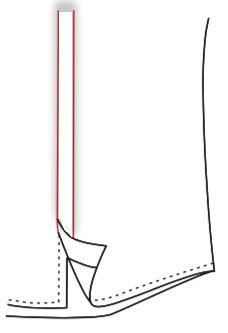 HID BUTTON PL FRONTPlacket with hidden button. Buttons are covered or hidden under the extra piece in the same fabric. Mainly for formal dress shirts special pleated front tuxedos. |
 PLAIN HALF HIDDENPerfect for medium to small tie knots and about as conservative as it gets. |
SHIRT POCKET STYLE
EPAULET
SHIRT EPAULETA small strap parallel to the shoulder seam, and the button near the collar, or by laces on the underside of the epaulet passing through holes in the shoulder of the shirt. |
SHIRT COLLAR OUTER FABRIC
Understanding the fabric is very important with the contrast option. Match the same weave as the main fabric.
E.g if your main fabric is a twill weave, choose twill weave fabric for contrast also. If your main fabric is linen, choose linen for the contrast fabric.
CONTRAST
In case choosing yes for contrast the fabric and where to place of placement of that fabric will be required
CONTRAST FABRIC CUFFS PLACEMENT
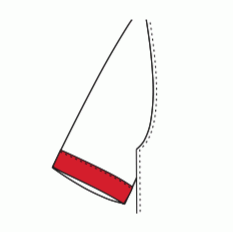
SHORT OUTER |

FULL OUTER CUFF |

MIDDLE HALF BACK |
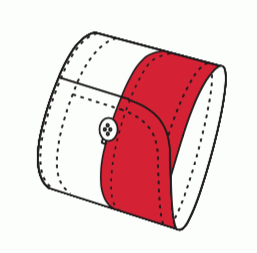
MIDDLE HALF FRONT |

TRIM MIDDLE CUFF |

TRIM EDGE CUFF |
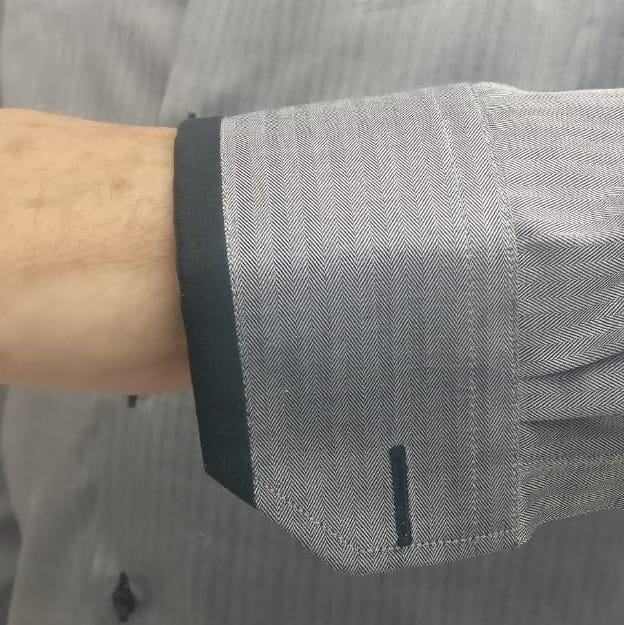 TRIM EDGE CUFF
TRIM EDGE CUFF
CONTRAST FABRIC PLACEMENT
 JACKET COLLAR.
|
||||
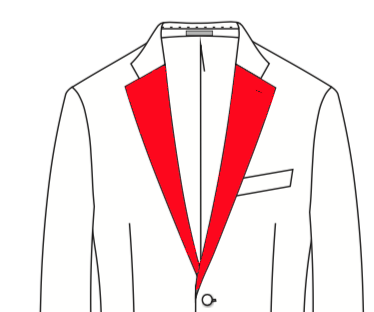 JACKET LAPEL
|
||||
 JACKET CHEST POCKET
|
||||
 JACKET LOWER POCKET
|
||||
JACKET TRIMMING
|
||||
JACKET BUTTONS.
|
||||
Pant Waist BandA waistband is a strip of material that is either elastic or some other confining fabric that encircles the waist. Choosing this option the waistband of the pants will be stitched with the contrast fabric selected.
|
||||
 Pant Belt Loops
|
||||
 Pant Back Pockets
|
||||
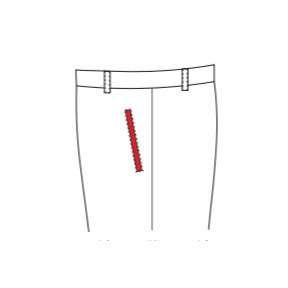 Pant Front Pockets
|
||||
Pant Side Band
|
||||
CONTRAST FABRIC COLLAR PLACEMENT
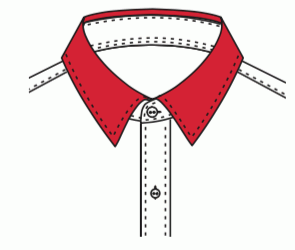 1. Full Outer CollarThis collar is eligible for all collars. The outer part of the collar will be stitched in the selected fabric as contrast fabric |
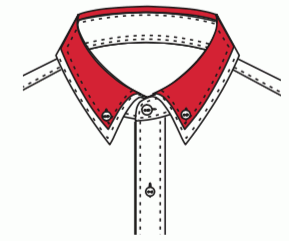 2. DUAL BUTTON-DOWN UPPER CONTRASTThis collar is designed with two layer of collar attached with neck band. The lower collar is little wider than the upper one just showing the ¼" edge of the collar. This collar is eligible only with button down collar only. The upper collar will be in the contrast fabric selected. |
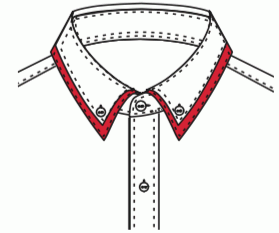 3. DUAL BUTTON-DOWN LOW CONTRASTThis collar is designed with two layer of collar attached with neck band. The lower collar is little wider than the upper one just showing the ¼" edge of the collar. This collar is eligible only with button down collar only. The lower collar in be in the contrast fabric selected. |
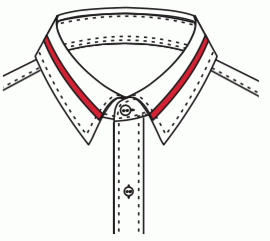
4. TRIM MID COLLAREligible with all collar styles. There will be a trim of just ¼" in the middle of the collar which will be stitch of the fabric selected as contrast fabric. |
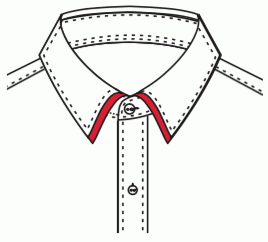
5.TRIM FRONT EDGEEligible with all collar styles. There will be a trim of just ¼" in the front of the collar which will be stitch of the fabric selected as contrast fabric. |

6.TRIM EDGEEligible with all collar styles. There will be a trim of just ¼" all around the collar which will be stitch of the fabric selected as contrast fabric. |

7.TRIM EDGE Button-downEligible with button-down collar style. There will be a trim of just ¼" all around the collar which will be stitch of the fabric selected as contrast fabric. |
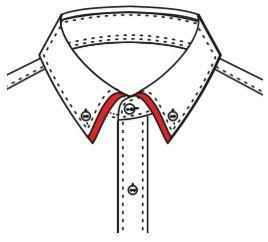
8.TRIM FRONT EDGE Button-downEligible with button-down collar style. There will be a trim of just ¼" front of the collar which will be stitch of the fabric selected as contrast fabric. |
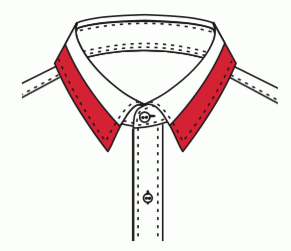
9. HALF BOTTOMEligible with all collars. Half Bottom part of the collar will be stitched with the fabric selected as contrast fabric. |

10. HALF TOPEligible with all collars. Half upper part of the collar will be stitched with the fabric selected as contrast fabric. |
3. DUAL BUTTON-DOWN LOW CONTRAST EXAMPLE
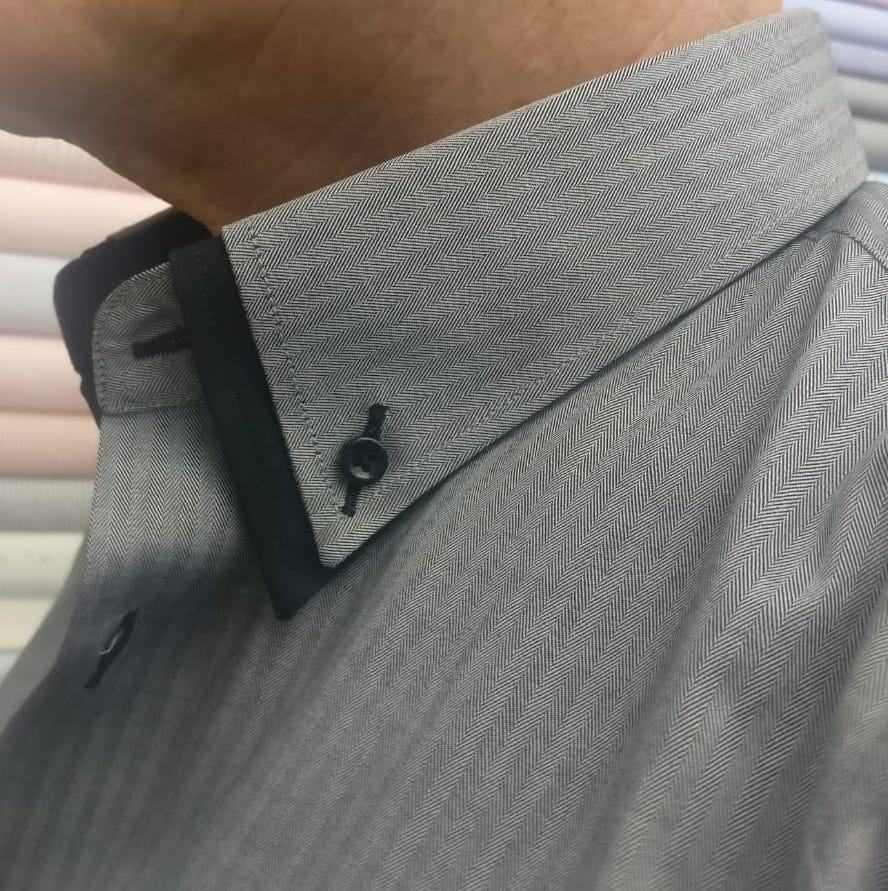
SHIRT COLLAR STAY OPTION(OPTIONAL)
Collar StaysA collar stay, collar stick, collar tab (British English), collar stiffener, or collar stiff is a shirt accessory consisting of a smooth strip of rigid material, rounded at one end and pointed at the other, inserted into specially made pockets on the underside of a shirt collar to stabilize the collar's points. The stays ensure that the collar lies flat against the collarbone, looking crisp and remaining in the correct place |
Button Down Casual Shirt-Limerick, linen Cyan Blue
- From US$ 0
* Price based on fabric selected.
Collection: custom made shirts
Product Code: RE210130
Availability: In Stock

For obtain more informations please Click here

